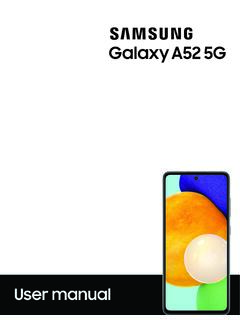Transcription of STM32MP1 Series interfacing with a MIPI® CSI-2 camera ...
1 IntroductionThis application provides information on how to interface STM32MP1 Series with a MIPI CSI-2 camera . The STM32MP1 Series ,like the STM32 high-performance MCUs can address CMOS camera sensors through its DCMI (digital camera moduleinterface) parallel port. However, it is possible to extend the range of addressable camera sensors for instance MIPI CSI-2cameras ( camera serial interface), thanks to the STMIPID02 MIPI CSI-2 deserializer discrete MIPI CSI-2 interface protocol has become for many years the standard technology in today s embedded sensors, mostlydriven by the mobile market and it is also widely used in the industrial market where MIPI CSI-2 brings decisive advantages,offering a lower pin count and cost versus the conventional parallel interface or MIPI STMIPID02 MIPI CSI-2 deserializer can address a broad range of MIPI CSI-2 camera sensors used in mobile devices andautomotive applications.
2 This direct interface removes the requirement for associated software overhead linked to framedecoding (for camera over USB or Ethernet for instance).The purpose of this application note is to demonstrate, using the DH96 Avenger board, the STM32MP1 Series capability toaddress the 5 Mpixel OV5640 MIPI CSI-2 camera sensor through the STMIPID02 MIPI CSI-2 deserializer. Both drivers areavailable and included in the STMicroelectronics OpenSTLinux software distribution package. For the purpose of this applicationnote and according to the STMIPID02 deserializer specifications, the focus is made exclusively on the MIPI protocolover a Series interfacing with a MIPI CSI-2 cameraAN5470 Application noteAN5470 - Rev 1 - September 2020 For further information contact your local STMicroelectronics sales informationThis document applies to STM32MP1 Series Arm Cortex core-based :Arm is a registered trademark of Arm Limited (or its subsidiaries) in the US and/or elsewhere.
3 The followingtable defines the acronyms needed for a better understanding of this 1. List of acronymsAcronymDescriptionCSIC amera serial interfaceCPIC amera parallel interfaceMIPIM obile industry processor interfaceDCMID igital camera interfacePMICP ower management integrated circuitLDOLow-dropout regulatorAN5470 General informationAN5470 - Rev 1page 2/342 Reference documentsBelow resources are public and available either on STMicroelectronics web site at or on third parties 2. Reference documentsReference numberDocument titleSTMicroelectronics documents(1)[R1]STM32MP15x datasheets(DS12500, DS12501, DS12502, DS12503, DS12504, DS12505)[R2]STM32MP151x/3x/7x device errata (ES0438)[R3] dual mode MIPI CSI-2 / SMIA CCP2 de-serializer (DS12803)[R4]Getting started with STM32MP151, STM32MP153 and STM32MP157 line hardwaredevelopment (AN5031)[R5]STM32 Arm Cortex -based MPUs user [R6]Linux V4L2 camera [R7]STCubeProgrammer (flash programming tool) [R8]Device tree [R9]OpenST Linux distribution.
4 #Reference_source_code[R10]Directory structure for the OpenSTLinux Distribution [R11]STM32 CubeProgrammer software tool: [R12] [R13] [R14] [R15] [R16] source software resources(2)[R17] (d3cameramezzov5640/d3-engineering)[R18] DH96 Board information: ( )[R19] [R20] (dh-electronics/manifest-av96)[R21] ( ) 1. Available at Contact STMicroelectronics when more information is This URL belongs to a third party. It is active at document publication, however STMicroelectronics shall not be liable for anychange, move or inactivation of the URL or the referenced material. AN5470 Reference documents AN5470 - Rev 1page 3/343 STM32MP1 Series interfacing with the STMIPID02 MIPI CSI-2deserializerThe STM32MP1 Series MPU family products do not natively implement a MIPI CSI-2 interface but embed a DCMI parallel port based on a MIPI CPI interface.
5 It can be connected through the STMIPID02 MIPI CSI-2 deserializerto address any compatible MIPI CSI-2 camera sensor device. The STMIPID02 MIPI CSI-2 deserializer isconnected to a MIPI CSI-2 camera on one side, and to the STM32MP1 Series DCMI12-bit data parallel interfaceon the other side. An overview of the block diagram is shown in the figure 1. Block diagram CSI-2 versus MIPI CPI interfaceThe MIPI CSI-2 pinout saving is interesting when compared to a MIPI CPI interface. A MIPI CPI data port requiresa minimum of eight data lines (of a maximum of 12 data lines), one clock, two synchronization lines, where a MIPICSI-2 data port requires 2-wire differential pair per lane, and the clock supply considerationsConsidering that the STMIPID02 deserializer bridge external power-supply voltage pins are limited to V, theSTM32MP1 Series must be supplied at VDD = V (instead of nominal V) to avoid the presence of levelshifters on the DCMI interface clocks and I2C signals.
6 All the different power voltages to the STM32MP1 Seriesare supplied through the external PMIC module (power management integrated circuit).For detailed information about the overall schematics refer to the DH96 board information [R18]. In order toconfigure the STM32MP1 Series in VDD = V supply voltage, refer to [R4].Regarding the OV5640 camera sensor, the VDD power supply for the I/Os and the LDO (low-dropout regulator)external source power source is set to V. For the analog logic, a V must also be supplied as well as theexternal Series interfacing with the STMIPID02 MIPI CSI-2 deserializerAN5470 - Rev 1page 4 Series video throughput performance through DCMIThe MIPI interface can theoretically achieve data throughput rates up to Gbyte/s per lane with a D-PHY.
7 This is hardly achievable on a parallel port interface due firstly to I/O slew rate pin constraints on a general-purpose device such as the STM32MP1 Series , which only have a MIPI CPI interface. Secondly because theMPU requires to process this large amount of data fast enough to sustain a continuous frame rate from instance, a 5 Mpixel sensor with 16-bit per pixel, and a frame rate of 30 frames/s, gives a data throughput of300 Mbyte/s processed continuously. This target is hardly achievable on a parallel port interface. Therefore, thesensor image data throughput must be reduced, by adjusting the image frame rate, the resolution, and the pixeldepth, or a combination of the OV5640 sensor to the STM32MP1 Series MPU through the STMIPID02 deserializer bridge it is possibleto continuously acquire images with the following resolutions and frames below.
8 720 p 1280 720 RGB 565 27 fps 720 p 1280 720 YUYV 27 fps 720 p 1280 720 JPEG 27 fps HD 1920 1080 RGB 565 13 fps HD 1920 1080 YUYV 13 fps HD 1920 1080 JPEG 6 fps 5 Mpixel 2592 1944 RGB565 3 fps 5 Mpixel 2592 1944 YUYV 3 fps 5 Mpixel 2592 1944 JPEG 3 fpsThe maximum performance achieved is 24 Mpixel/s or the equivalent of Mpixel at fps. This limitation ismostly due to the impact of the DCMI internal latency constraints as previously described in this Linux driverThe STMIPID02 MIPI CSI-2 deserializer bridge is designed to address a broad range of MIPI CSI-2 sensorstargeting the consumer market and specifically mobile phone applications.
9 To satisfy the growing demand toaddress this type of sensors from the industrial to IoT (Internet of Things) market through the artificial intelligencedomain, the STMIPID02 driver has been upstreamed to the Linux community. It is freely available in Linux basedapplications. The STMIPID02 bridge driver is included in the STMicroelectronics OpenSTLinux delivery package,starting from version and Series video throughput performance through DCMIAN5470 - Rev 1page 5/344 Overall applicationThe camera demonstrator is part of the GTK demo launcher application, based on the OpenSTLinux softwaredistribution package.
10 It is ported on DH96 boards featuring the STM32MP157A and the STMIPID02 on the DH96 Avenger board and the camera sensor OV5640 on the D3 Engineering DesignCore camera mezzanine Avenger96 board overviewThe DH96 Avenger mother board integrates: ADH Core SOM module composed of the STM32MP157 AAC microprocessor STPMIC1A power module 2 Mbytes 512 Mbytes of DDR3L RAM STMIPID02 deserializer bridge 2-Mbytes SPIboot Flash memory connectivity and expansion connectors to receive the D3 DesignCore camera mezzanine board more information, refer to [R18]. D3 Engineering DesignCore board overviewThis mezzanine board is designed to fit the Avenger96 board through both high and low-speed expansionconnectors for the STM32MP157 line.














